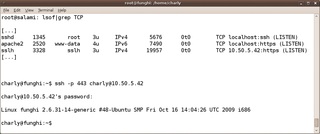
By Charly Kühnast
Whether I happen to be in an Internet café, using the wireless LAN at a hotel, or using a public hotspot at an airport, I continually find myself locked up behind a firewall that refuses connections to target port 22. Of course, any firewall will generously let traffic to ports 80 and 443 pass.
In other words, it's a good idea to bind the SSH daemon to the HTTPS port on my servers. This saves me digging a tunnel, and I can simply log in to my server with ssh -p 443 <user>@<host>. But if the HTTPS port is already occupied by an SSL-capable web server, I have to put my thinking cap back on. Enter sslh [1].
The makers of this tool call it an SSL/SSH multiplexer. The underlying idea is that the multiplexer listens on port 443 and discovers for incoming connections whether the client wants to speak HTTPS with SSH to the host. The services themselves are bound to localhost:443 and localhost:22, respectively (Figure 1). Sslh retrieves this information from the /etc/defaults/sslh file, which looks like the following in a simple setup:
RUN=yes DAEMON_OPTS="-u sslh -p 10.50.5.42:443 -s 127.0.0.1:22 -l 127.0.0.1:443 -P /var/run/sslh.pid"
To find out which protocol is currently required, sshl analyzes the client's behavior. In the case of an incoming HTTPS connection, the client waits for the server to signal that it is ready to receive. A client requesting an SSH connection will not wait but will open the dialog itself, and sslh will just wait for a short time, typically two seconds. If the client does not send any data in this time, sslh assumes that it is an HTTPS connection and forwards it to the web server at 127.0.0.1:443.
To restrict the Apache server to localhost, I have to change the list parameter in its configuration that sets SSL to 443 by default to 127.0.0.1:443. Strictly speaking, you do not necessarily have to bind the SSH port to localhost because there is no conflict with another daemon on port 22. However, I did this for two reasons: First, it protects me and my auth.log from a whole bunch of scans that keep on turning up at that address. Second, I can reach the server via a serial console if SSH or sslh should fail for some reason.
| INFO |
|
[1] sslh: http://www.rutschle.net/tech/sslh
|
| THE AUTHOR |
|
Charly Kühnast is a Unix operating system administrator at the Data Center in Moers, Germany. His tasks include firewall and DMZ security and availability. He divides his leisure time into hot, wet, and eastern sectors, where he enjoys cooking, freshwater aquariums, and learning Japanese, respectively. |